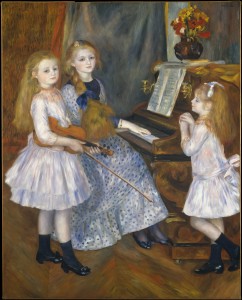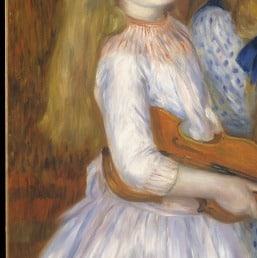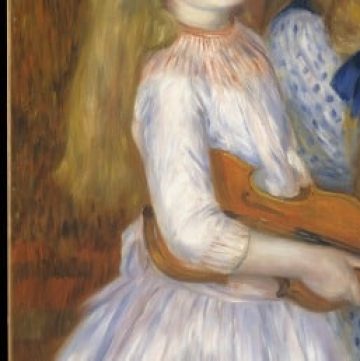
Repetition Activities
Children (and adults) learn songs by repetition, but simply singing the same song over and over is boring. Here are some more interesting activities to help children learn or memorize a song. All these activities require singing or listening to the same song several times.
Obey the Signs
Stop/Go: Sing when “go” is up. Listen to the piano when “stop” is up.
Hum/Sing: Hum when “hum” is up. Sing when “sing” is up.
Soft/Loud: Sing softly when “soft” is up. Sing loudly when “loud” is up. Warning: Prior to doing this one, explain that “loud” means singing with lots of volume but still beautifully and reverently, never yelling. Demonstrate by singing a line softly then loudly.
Ensemble Cards
Have several cards that list different categories of people, such as boys and girls, certain eye or hair colors, adults and children, wearing certain colors of clothing, etc. When you hold up a card, everyone in that group stands and sings. Everyone else sits and listens.
Put the Song in Order
Create picture cues or word strips for the complete song. Pick one cue at a time. Sing through the song or play a recording of the song and have the children listen for the phrase in the cue. Ask the children to indicate where to place the cue by raise of hands: “Who thinks it comes before this cue? Who thinks is comes after?” Place the cue on the board with a pin or magnet approximately where the majority of children think it belongs. Continue to choose and rearrange the cues until all are in order.
Delete Cues
Create picture cues or word strips for the complete song. Remove one cue and sing the song, relying on memory for that part. Continue until all cues are eliminated.
Hide the Poster
Create a poster with words or pictures for the complete song. Check out several pictures related to the message of the song. For example, for a song about service, choose pictures of people helping others in a variety of ways. Have a child choose a picture and describe how it relates to the message of the song. Then have them place the picture on top of the poster with light tape or a magnet, covering parts of the song. Sing the song, relying on memory for the hidden part. Continue until the poster is completely hidden.
B-I-N-G-O
Choose a word that is frequently repeated in the song and have children clap instead of sing that word. For younger children, the next time, choose a different word they must clap instead. For older children, the next time, add another word they must also clap, and continue until they must clap through many words of the song.
Quiz
Create a quiz about the song. Each question should be answered by a line in the song and should be listed in the order it is found in the song. For older children, print out the quiz and let them fill in the answers while listening to a recording of the song. After the song is completed, ask the children to raise their hands if they have written all the answers to the quiz. If not, play it again. Continue until most children have heard and written most of answers. Then go over the quiz together and have the children say the answers together. For younger children, verbally tell them the first question and play the beginning of the song. Then ask the children to raise their hands if they know the answer, but not say it out loud. Play that part until most children know the answer. Then ask the children to say the answer together. Tell them the next question. Play the song again, this time playing a little more of the song. Repeat the process until the whole song is played.
Chorister Soloist
When you point to yourself, you sing alone. When you point to the children, they sing without you. If the children do not come in when pointed to, review the part that confused them and start again. Continue until the children can always come in when pointed to without mistakes.
Hot and Cold
Send a child and an adult supervisor out of the room. Hide an object in the room. Bring the child back into the room to look for the object. Have the other children sing quietly when the child is far from the object and loudly when the child is close until the child finds the object.
Four Corners
Label each corner of the room: 1, 2, 3 and 4. Choose a group of children to go to find corners to stand at while the remaining children sing the song. When the song is completed, ask a child to draw a number. All children standing by that number sit and join the singers. To motivate extra-good singing, let the children draw 2 numbers, and therefore catch more people, only on the times when they sing the song particularly well. Repeat the song. Continue until all children are sitting.






6 Responses
Lots of great ideas, April. I’ve used some of these myself. The senior primary particularly liked the put the song in order idea. Both junior and senior primary liked deleting cues.
Mostly I found what works for junior primary does not work for senior primary, and vice versa. Which makes me think that in large wards who can have enough people to staff two positions, they should call a senior primary chorister and a junior primary chorister. That way one person doesn’t have to do double prep, and each chorister gets to attend one adult meeting per Sunday.
Best solution is reduce 3 hour block. Much of Primarys 3rd hour ia filler.
April, These are all great ideas. Primary music leader has to be one of the best callings in the church, as soon as you make up your mind to just stop being too embarrassed to sing by yourself in front of everyone.
I’d love to see the 3 hour block shortened too, but the music in primary is the best part, so I wouldn’t want to lose that. And when a music leader does lots of interesting stuff like April, it’s the one part of church where the children can have fun and be full participants.
This is such a handy list! But, can I make a confession? I can’t do the BINGO exercise when I substitute…I forget which word we’re doing or clap late. It’s a hot mess.
Oh wait…maybe that’s why the kids always want me to do that one when I substitute.
These tips are awesome, April. I’m tempted to forward this on to our primary chorister!
[…] Fun Ways To Practice That Primary Song Again And Again And Again AND The Assistant Primary Chorister Teaching songs to children… […]